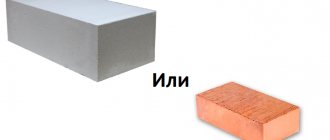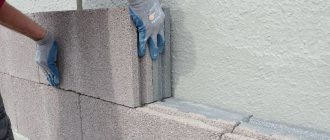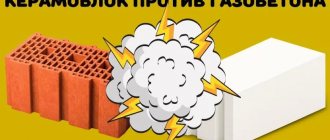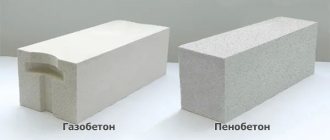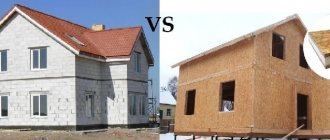Beton-House.com
Website about concrete: construction, characteristics, design. We combine the experience of professionals and private craftsmen in one place
What blocks to build a house from: aerated concrete or polystyrene concrete
Anyone who wants to build a house probably had to make a choice between one or more similar materials. Sometimes, it is quite difficult to distinguish some products from others due to the superiority of various indicators.
In this article we will try to do this. So, which is better, aerated concrete or polystyrene concrete?
- Pros and cons of aerated concrete
Definition
Aerated concrete is cellular concrete. It contains fine quartz sand, metallurgical or ash slag, Portland cement (grade M400), additives for the formation of gas bubbles. Production is regulated by GOST 25485-89. Aerated blocks can be autoclaved or non-autoclaved.
Polystyrene concrete is a composite type of lightweight concrete. It consists of Portland cement and porous aggregate (foamed polystyrene in granules), an air attraction additive (ADA) and water. Thermal insulating material (polystyrene granules) and concrete in combination provide an optimal combination of qualities: the material does not rot, does not absorb moisture, has high strength, thermal insulation, sound insulation, fire resistance, frost resistance and a long service life.
Polystyrene concrete is used:
- in partitions and load-bearing walls, enclosing elements of frame buildings, as insulation for floors, attics, walls, roofs;
- as construction and fire insulation;
- for floor screed;
- for the production of decorative insulation elements for facades, building blocks, and liquid mortar.
With good structural strength, it has the advantages of wood (ease of processing), concrete (high strength), expanded polystyrene (good heat and sound absorption properties).
What is included in a house project
Foam block house projects involve low-rise construction. As practice shows, more is not necessary, especially since according to the law, the maximum permitted height of houses for suburban construction is 3 floors.
Projects may include load-bearing columns, but made of other materials (not foam concrete!). Additional foundation reinforcement will also be required.
The house design must include the following data:
- All dimensions and, if available, slope angles of all structural elements (roof, for example);
- Additional structural elements (roof sheathing, air duct routing, for example);
- Layout of all rooms and floors;
- All engineering communications, their entry points;
- Step-by-step estimates indicating the quantity and cost of all materials;
- The façade layout including all windows is provided separately.
Specifications
| Characteristics of aerated concrete | Characteristics of polystyrene concrete |
| 1. Low thermal conductivity. The porous structure makes the blocks an insulating material. 2. Lightness. The low weight of the blocks reduces the cost of transport work and the labor intensity of construction. 3. Thermal accumulation. Cells in the structure accumulate heat from batteries or the sun. In winter this saves heating materials, in summer it provides coolness. 4. Sound insulation is 10 times higher compared to brickwork. 5. Fire resistance. Natural mineral raw materials in the composition provide resistance to fire. 6. Frost resistance. Reserve pores, into which water is displaced during frost, protect the material from destruction. 7. Durability. Strength is achieved through autoclave processing. 8. Cost-effectiveness and speed of construction. The large dimensions of the mounted blocks with their relative lightness make it possible to save on labor costs. 9. Constructiveness. The clear geometric shape allows the structures to be mounted using an adhesive solution, which ensures the absence of “cold bridges” in the masonry. 10. Ease of processing. The material can be processed in any way: drilled, sawed, grooved, planed, nailed. 11. Eco-friendly. The materials used in production are environmentally friendly and second only to wood in naturalness, but do not rot or age. | 1. Durability. Designed service life is 100 years due to high resistance to temperature fluctuations. 2. Durability. PSB can withstand 35t/m, compressive strength from 0.73 to 3.6 MPa, tensile strength from 0.08 to 0.73 MPa. It is characterized by crack resistance and impact resistance. 3. Lightness. A block equal in volume to bricks weighs several times less. At the same time, the construction speed increases, and the weight of the structure decreases. 4. Thermal insulation. Thermal characteristics are comparable to wood. A 1.5 m thick brickwork is comparable to a 30 cm thick wall. Energy consumption is reduced by 5 times on average. 5. Endurance. Temperature fluctuations -40 C – +70 C and exposure to ultraviolet radiation are not dangerous for the blocks. 6. Fire resistance. Doesn't smolder, doesn't burn. 7. Biostability. Not exposed to mold, rodents, or decay. 8. Soundproofing. The pores absorb sound well and provide sound insulation. 9. Vapor permeability. High waterproofing prevents the absorption of moisture, hygroscopicity is 5 times better than that of aerated concrete. 10. Eco-friendly. Polystyrene, water - the components are safe for humans. |
Main results
Having considered the main qualities and characteristics, as well as production conditions and individual characteristics of each material.
Let's summarize the main results:
- The thermal conductivity, vapor permeability, and environmental friendliness indicators of both materials are very similar.
- Polystyrene concrete is superior in frost resistance, but at the same time it is inferior to aerated concrete in density and shrinkage percentage.
- The varieties and sizes available allow you to choose the most suitable product option from both materials.
- Both aerated concrete and polystyrene concrete are easy to process, are lightweight and have fairly large dimensions, which will allow you to erect a building in the shortest possible time, without resorting to the help of specialists.
- If you decide to make the blocks yourself, this is possible. You will have to incur small costs for equipment and raw materials. But, with a rational approach, the result will be positive
- When choosing products, pay attention to the block manufacturer. And only after making sure of the high quality and availability of accompanying documents, purchase the product.
It’s difficult to say unequivocally: aerated concrete or polystyrene concrete; each material is good in its own way. Well, the final choice is yours!
Types of polystyrene concrete
Various products are produced on the basis of PSB.
- Large wall blocks . Reinforced MEGAplast blocks are large-sized wall blocks of improved strength and reliability. These are high quality polystyrene concrete blocks, convenient and quick to construct both low-rise and high-rise buildings.
- Wall block . Polystyrene concrete blocks are used for the construction of self-supporting and non-load-bearing enclosing structures in frame construction; in cottage and low-rise (up to 3 floors) construction for laying external load-bearing walls when using reinforced concrete and wooden floors; for adding additional floors to existing buildings. They are produced as “Groove-groove” and “Groove-ridge”.
- Partition blocks . Self-supporting structures for interior partitions.
- polystyrene concrete lintel , dimensions 1290x300x188 mm. The support on each side is 20-25cm. It is used to cover door and window openings in internal and external walls, as a structural element that covers the opening in the wall and takes the load from the structure located above.
- Jumper blocks . A block reinforced with steel reinforcement with a density of 0.6 t/m3 is the basis for a lintel of 1.5 - 4.5 m. It is used for door and window openings. Being load-bearing elements, they also have a thermal insulation function.
- In the construction of U blocks for armored belts are actually used as a unique building material, which is a formwork. The intended purpose of formwork building materials is to shield heat loss. In construction, U-shaped blocks for armored belts, in addition to their intended purpose, are used to create various units with enhanced strength characteristics.
- Blocks for ventilation . Hole 110 mm. During the construction process, it is important to think through all the components of a successful building. One of the most essential details is the construction of ventilation ducts, without which normal air exchange in the premises is impossible.
- Blocks for fence posts. A reliable fence is a necessary element of any site. The construction of such a structure begins with posts; this is the main component of the fence, which requires a serious approach to the choice of material. Polystyrene concrete block for fence posts, as the most durable, durable and inexpensive, occupies the first position in this field of use.
Types of aerated concrete
Depending on their purpose, blocks are divided into several types.
- Wall. Thick, intended for installation of external structures. Thickness from 25 to 50 cm.
- Jumpers, partitions. For interior partitions, long elements with a thickness of 10–15 cm are used. For lintels inside the walls, elements of greater weight are used due to frame reinforcement for greater strength.
- "Groove-ridge." One side with ridges, the other with corresponding grooves. The system provides high precision installation, forming a “lock”. There is no need for glue - costs are reduced, there are no cold bridges, thermal insulation is improved. There are grips that facilitate installation and speed up work.
- Direct. Various sizes, suitable for internal and external walls. They also have “handles” for operation.
- U-shaped. Suitable for creating lintels, reinforced belts, columns, ceilings (installed on formwork and glued). Concrete is poured into the resulting gutter. Light weight and high thermal insulation are the main differences from reinforced concrete.
- Arc-shaped. Necessary for the installation of round structures. Partitions of complex shapes, towers, stairs, design solutions and other smooth shapes are achieved with arched blocks.
- Jumpers. Additionally reinforced and made from high-quality concrete.
Comparison table of both materials
Despite the relative novelty of the materials, this did not prevent them from gaining consumer recognition.
The comparison table shows how the performance of the blocks differs.
Comparison table 1
| Material | Aerated concrete | Polystyrene concrete |
| Density kg/m3 | 400-800 | From 250 |
| Compressive strength, class | V 2.0-V 3.5 | V 0.5-V 2.5 |
| Thermal conductivity | 0,1-0,14 | 0,1-0,145 |
| Water absorption | 20-25% of the total mass | 4% of the total mass |
| Recommended wall thickness | From 0.4 m | From 0.3 m |
| Vapor permeability | 0.2 mg/mh Pa | 0.2 mg/mh Pa |
| Frost resistance | From 50 cycles | From 300 cycles |
| Shrinkage | 0.03 mm/m2 | From 0.3 mm/m2 |
| Brand by density | D350-D700 | D250-D700 |
| Soundproofing | Average | Average |
| Price category | Average | Average |
Pros and cons of aerated concrete and polystyrene concrete
Despite the obvious advantages, polystyrene concrete and aerated concrete have both pros and cons.
| Polystyrene concrete | Aerated concrete | |
| Vapor permeability | + | + |
| Moisture absorption | + | — |
| Operational resource | + | + |
| Soundproof | + | + |
| Biological resistance | + | + |
| Thermal insulation | + | + |
| Environmental friendliness | + | + |
| Fire safety | + | + |
The main disadvantage of aerated concrete is the shrinkage of the material. As a result, the blocks become covered with a web of cracks, which does not affect the operational properties of the structure, but is reflected in its appearance. To prevent cracks from being noticeable and from growing, it is necessary to choose finishing materials that will mask the defect. For the construction of residential buildings, it is necessary to use durable grades D500 and D600 - the material is durable, but fragile. Also, aerated blocks have high moisture absorption; wet aerated concrete retains heat much worse, and therefore, freezing of houses is possible.
Among the disadvantages of polystyrene concrete, the need to use special anchors and bolts for lightweight concrete for fasteners is noted.
Algorithm for comparing cellular and porous concrete
Let's compare according to the following scheme:
- Let's define concrete.
- Let's select a comparable range of blocks and get acquainted with the technology for their production.
- We will determine standard parameters for each type of concrete according to the following criteria:
- Physical and mechanical characteristics;
- Thermophysical characteristics;
- Design features;
- Technological features of installation;
- Convenience and reliability of operation of the constructed house.
- Let's estimate the price range of each material.
- Let us formulate the main differences between aerated concrete and polystyrene concrete.
- Let’s determine the most effective areas of application of the products and summarize: which of the blocks is more suitable for which purposes.
Types of lightweight concrete: cellular, gas silicate and porous, with polystyrene filler
In order for our assessments to be objective, we will compare the indicators provided for by the relevant GOSTs. This is a legitimate assumption: if a product is certified, its parameters fully comply with the standard. We will not evaluate the quality of garage-made products - its level is at least unstable.
We will consider autoclaved concrete as aerated concrete. We will take the parameter values from STO-NAAG 3.1-2013 - an updated edition of GOST 31359-2007. The standard is called “Structures using autoclaved aerated concrete in the construction of buildings and structures. Rules for design and construction." The document is valid.
We will get information about polystyrene concrete from GOST 33929-2016 Polystyrene concrete. Technical conditions".
Construction calculations
To decide what to build a house from, you need to calculate the economic benefits of using each material per 1 m2.
| Polystyrene concrete | Gas block | |
| Wall thickness | 30 cm | 30 cm |
| Price | 600*300*380 D400 - from 175 rub./piece. | 600*300*200 D500 - from 110 rub./piece. |
| Quantity per 1 m2 | 5 | 8 |
| Price | 900 R | 900 R |
| Thermal insulation | not required | not required |
| Seam thickness | 5 mm | 2-3 mm |
A comparison shows that the difference is small. If aerated concrete is cheaper per piece, then when calculating per meter the cost is the same. At the final stage, construction from aerated blocks is more expensive, because the material needs to be insulated and then finished. The polystyrene concrete material does not require insulation, therefore it significantly reduces the cost of construction.
Feedback on materials
Builders, like owners of houses made from modern materials, note their advantages and disadvantages.
Construction from polystyrene concrete blocks
- Experts note that the lightness of the structures reduces the load on the foundation, and ease of installation speeds up work. Walls of complex architecture can be removed in a short time. The house will be durable, warm, and resistant to seismic loads. The blocks are easy to work with and easy to install.
- Owners of buildings claim that such houses are warmer than concrete ones and have a good level of sound insulation. There is a pleasant microclimate inside, the air is light, it’s pleasant to breathe and there is no feeling of a “plastic box”.
Disadvantages: possible shrinkage of the building and the appearance of microcracks.
Alexander (Moscow region) writes: “The house was built in six months. I'm happy. Warm, dry. We built 2 floors. Cracks appeared in some places while the exterior was not being finished, but this does not bother me - these are not finger-sized ditches, it looks normal.”
Construction from aerated concrete blocks
- Builders claim that working with aerated concrete is easy. The construction of a house of 2 floors is 3 times faster than a brick one. The material is easy to work with, lightweight, and does not require a large team.
- House owners write that aerated concrete is bad for building more than 2-3 floors. Additional calculations are required; walls may crack due to soil shrinkage. The houses are cheap, warm, and allow you to significantly save on heating costs.
Disadvantages: the house needs to be finished; without plaster it looks untidy. It is imperative to carry out internal work first, then external work, otherwise moisture will be transferred through the wall and may affect the finish. To hang a TV or shelf you need special fasteners - the walls are fragile, simple fasteners turn.
Tatyana (Krasnoyarsk): “We built a dacha from blocks. Warm. For us this was the most important thing. However, it was necessary to make fresh ventilation, otherwise dampness would develop inside. But we like the house - it warms up quickly when it’s sunny outside, and in winter we don’t go there.”
Comparison results
Having understood the characteristics of the compositions of various types of blocks and the nuances of manufacturing, we can objectively assess what is better - polystyrene concrete or aerated concrete.
- Aerated concrete is good for construction under normal conditions. Most suitable for solid foundations laid taking into account soil requirements.
- PSB is an excellent material for building houses in conditions of high humidity. Particularly effective in the construction of kitchens, bathrooms, and laundries. Good for basement floors.
It turns out that the truth is in the middle: the best option when building a house is to wisely combine polystyrene concrete with aerated concrete and other materials.





